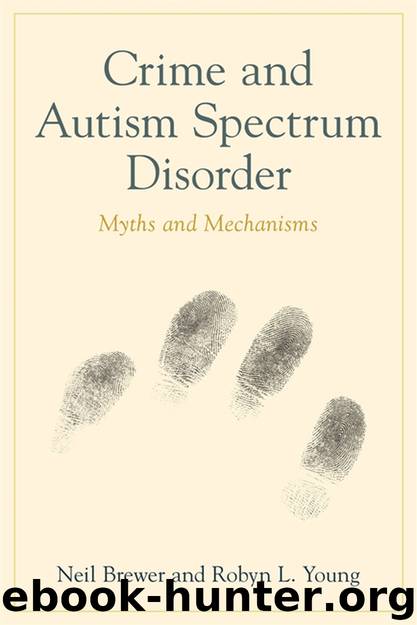Crime and Autism Spectrum Disorder by Brewer Neil Young Robyn Louise

Author:Brewer, Neil, Young, Robyn Louise
Language: eng
Format: epub
ISBN: 9780857007735
Publisher: Jessica Kingsley Publishers
Published: 2015-05-24T16:00:00+00:00
The Message from These Case Studies
On many occasions throughout this book we have cautioned that case studies such as those presented in this chapter are, at best, suggestive of mechanisms that may underpin the involvement of persons with an ASD in criminal activity. And we repeat that message here. Nevertheless, we believe that there are several prominent themes that emerge from these case studies that should be highlighted because they have important implications for the operation of the criminal justice system.
First, none of the crimes identified in the case studies we have outlined appear to have been premeditated by the accused or committed with malice or intent to harm. In all but one of these cases the likely outcome of the behaviour appears to have received no consideration at the time of the offence. In the case of Kallen (Case A5), he was coerced and motivated by self-preservation rather than any deliberate attempt at wrongdoing. In all cases the perpetrator needed to be educated about the seriousness of the offence and the impact their behaviour had on the victim. Second, in all cases the perpetrator of the crime showed what in everyday terms would likely be called very poor judgement. In other words, the perpetrator appeared not to recognise or understand the intent of another person or seemed oblivious to the potential impact of their behaviour on other people. As we have seen in earlier chapters, these deficiencies are commonly observed in some form and with some degree of severity in many people with ASD. And, as we argued in Chapter 5, they may – given certain enabling environmental conditions – explain how a person with an ASD may sometimes behave completely inappropriately and unlawfully – indeed naively or unwittingly – without any intent to violate the law. Third, in many of the cases the individual’s behaviour was related in some way to their pursuit of an extremely strong restricted interest or obsession and, occasionally, to hypersensitivity to sensory stimuli. In other words, it is as if the special interest or obsession (or hypersensitivity) increased the likelihood that they were blinded to the intent of others or the consequences of their own actions – or exacerbated the potential impact of their ToM deficit(s) in particular situations.
There are two other noteworthy characteristics of some of these cases. One is that the offender appeared to become involved because they acceded to the wishes of someone they hoped to befriend or, perhaps, impress. It is as if there was a meshing of their social-communicative limitations and ToM deficits, deficits that are of course not independent of each other. A feature of the disorder is that affected individuals lack the requisite skills to form friendships, and they behave in ways that constrain their capacity to make friends. This, in turn, may increase the individual’s vulnerability to comply with requests from people who appear to provide them with an opportunity to secure a friendship and yet are inviting them to engage in criminal behaviour. In
Download
This site does not store any files on its server. We only index and link to content provided by other sites. Please contact the content providers to delete copyright contents if any and email us, we'll remove relevant links or contents immediately.
| Allergies | Asthma |
| Autism & Asperger's Syndrome | Cystic Fibrosis |
| Down Syndrome | Eating Disorders |
| Epilepsy | Learning Disorders |
| Lice | Special Needs Children |
I Capture the Castle by Dodie Smith(1567)
Aspergirls by Rudy Simone(1356)
Be Different by John Elder Robison(1325)
Autism's False Prophets by Paul A. Offit(1237)
My Child's Different by Elaine Halligan(1226)
Smart but Scattered—and Stalled by Richard Guare(1191)
What's Making Our Children Sick? by Michelle Perro(1153)
101 Tips for the Parents of Boys with Autism by Ken Siri(1149)
Asperger Syndrome (Autism Spectrum Disorder) and Long-Term Relationships by Ashley Stanford(1111)
ADHD by Mark Selikowitz(1103)
An Adult with an Autism Diagnosis by Gillan Drew(1067)
Girlish by Lara Lillibridge(1062)
Nerdy, Shy, and Socially Inappropriate by Cynthia Kim(1051)
Animal-assisted Interventions for Individuals with Autism by Temple Grandin(1033)
On Immunity: An Inoculation by Biss Eula(1025)
Seeing Ezra by Kerry Cohen(1001)
Overcoming ADHD by Stanley I. Greenspan & Jacob (con) Greenspan(987)
Why Gender Matters by Leonard Sax M.D. Ph.D(979)
Sarah's Child (Hqn Romance) by Linda Howard(974)
